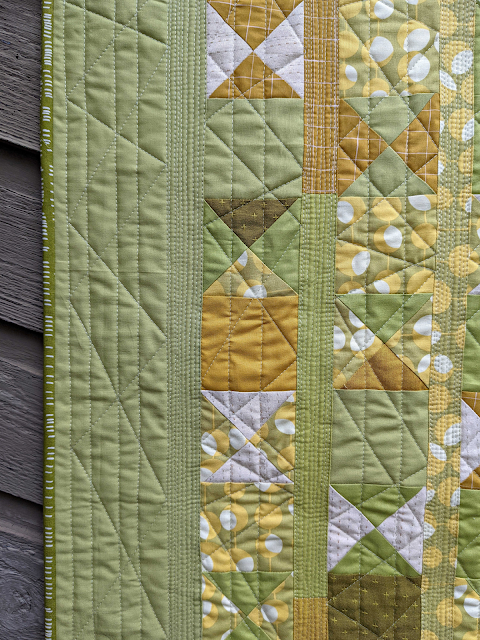"Tears" is my third experience with Visio Divina in the last several months, the practice of contemplating with the eyes, ie. through visual art. It has indeed been a unique opportunity to create quilted liturgical pieces in response to upcoming worship texts. To share this project with as wide an audience as possible, I'm choosing to print the actual artist statement that will be shared with my church congregation in italics; more general quilt info in regular font. Feel free to enjoy it however you like.

This upcoming Sunday, November 7, will be recognized in many denomination as All Saints Sunday, among other things, a day to remember those loved ones who have passed away. Both of the texts our church will be using (Isaiah 25:6-9 and John 11:32-44) speak of tears. In my use of fabric in responding to these texts, I couldn’t not keep thinking of all the tears, thus I used a silver metallic fabric as the basis of the pieced blocks to represent those tears. With the varying yellow and gold fabrics, I was, in short, trying to convey hope, despite the grief many experience.
Both texts for All Saints Day speak of tears. In Isaiah, “God will wipe away the tears from every cheek;” and in the Gospel of John, there was much weeping at the death of Lazarus, both by his family and friends, and even by Jesus himself. In my use of fabric in responding to these texts, I couldn’t not keep thinking of all the tears, thus I used a silver metallic fabric as the basis of the pieced blocks to represent those tears. With the varying yellow and gold fabrics, I tried to express the life – both here on earth and the hereafter - the hope we have in Christ Jesus, a glimpse of the glory that God offers each of us.

The silver print was Mark Hordyszynski's Mirror Ball Dot for Michael Miller Fabrics - remember that old favorite? The solids were a mix of yellows, golds, and gold-greens, chosen solely because I liked them together and they were so cheery. The triangle and solid blocks both measured 3" x 4.5". I had a tiny Nifty Notions triangle template (1.5" x 3" tall) that got me started, but then it was improv until time to trim the blocks to size. By the time the top was done, I had started to think about binding, and when I found the piece of Alexia Abegg's Heirloom Warp and Weft Shirtwaist in Goldenrod in my stash, I knew it needed to be included.
I was also drawn to the last part of the gospel lesson where Jesus said, “Untie him [Lazarus] and let him go free.” Not only does this command speak of new life, but it was striking that Jesus didn't unwrap Lazarus himself, but instructed the crowd to. The inclusion of the community there felt important, and I chose to represent that community – the ‘us’ in the story – by the striped fabric used in the quilt’s binding. Imagine us all surrounding and supporting our siblings in Christ in their grief, as in their life.
But before I got to that, of course, a quilt back was in order, and I let the stripe become a key player. In my mind, I used the single solid sample tear block as a start, surrounded and supported by more 'tears' (the dot fabric) as well as the community, (the stripe). With the quilt back expanding on the story of the quilt front, I love it just as much.
For quilting, I used two Aurifil 50wt 2115 [Lemon] and 2140 [Mustard], stitching a mix of straight-line, organic straight-line, and matchstick quilting. Always a fun mix.
For binding, in addition to the stripe, I also used
Kona Grellow and
Cotton Couture Citrus to keep with the mood of the piece. At its finish, it measured 25" x 36.5"
And knowing some of you would want to see how the quilt was being used, here is the graphic that is being used on the bulletin for Sunday's service.
Photo graphic by Josh Judd-Herzfeldt. Used by Permission.
The quilt will also be displayed for the congregation to see. And so I added a postscript to my artist statement that is also being shared in the bulletin, encouraging them to check out the back and experience the rest of the quilt's story.
P.S. Once I thought of using the striped fabric to represent the community standing in support, I was regretting not using more of it in the quilt’s front. Since it was too late for that, I included it as I pieced the quilt’s backing, where one single tear block is suspended, not only by a sea of tears, but supported by the strong ‘arm’ of community. I invite you to feel free to glance at the back of the quilt if you have a chance, and be reminded of the part we all play in God’s promise of hope and resurrection.
See A Storm Story and Born from Above if you're interested in my previous liturgical quilts.






























